Monday, January 28, 2008
7 Abandoned Wonders of the Former Soviet Union: Deserted Cities, Buildings, Bases and More
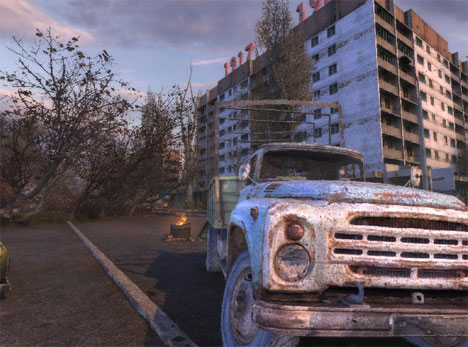
There are amazing abandonments in America and many modern wonders of the world, but the former Soviet Union has some of the most interesting, unique and strange abandoned buildings. The complex political, military and social history of the country has led to everything from almost-finished buildings abandoned before actual use and entire abandoned cities to chilling gulags in which tens of millions of prisoners met their end.
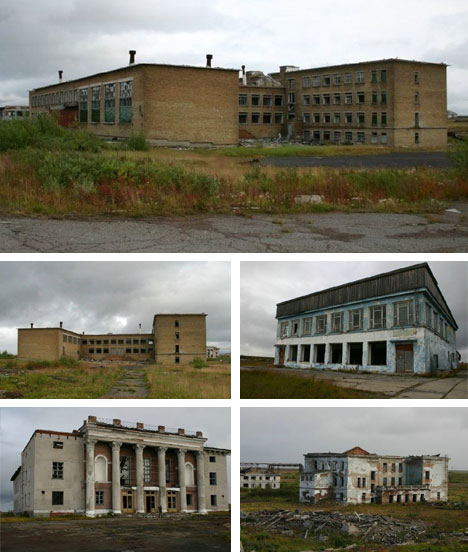
Abandoned City: Promyshlennyi, Russia was abandoned with the fall of the Soviet Union, cut off from communication with and support from the government. When utilities and electricity stopped working, people simply left to find a home and work elsewhere, leaving buildings behind and many belongings in the wreckage. Today, the remnants of the things they owned and buildings they inhabited remain relatively untouched.
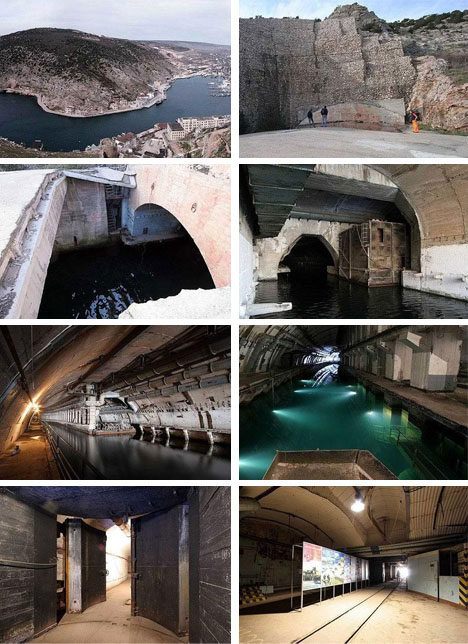
Abandoned Submarine Base: Balakava is a small town on the Black Sea Coast that was once the secret home to a Soviet nuclear submarine base. People with resident family members were not even allowed to visit the town without special dispensation from the government. Today, all of the submarines are gone but the base remains remarkably intact and can be visited by urban explorers from around the world.
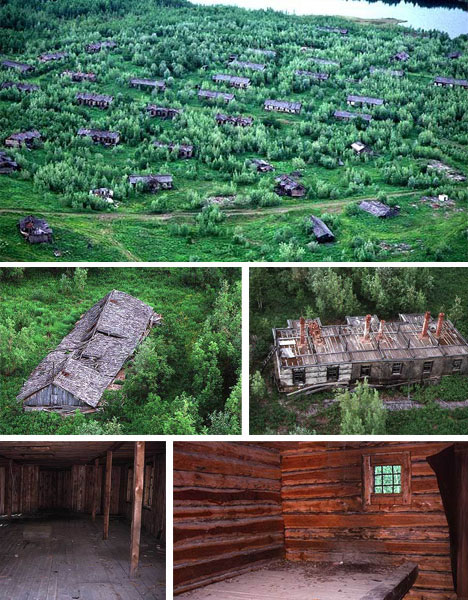
Abandoned Prison: Like concentration camps in Europe, the gulags are unique to Russian history. Abandoned gulag buildings are the physical evidence of mass imprisonment, forced labor and tacitly approved extermination. “Roosevelt observed that capitalism is unequally divided riches while socialism is equally divided poverty. Gulag prison life meant an equal distribution of death among the rich and poor, old and young.”

Abandoned (Never Used) Buildings: In most countries, abandonments remain in the wake of long-deserted structures that once saw heavy use. In Russia, some industrial, medical and administrative abandonments are merely the remnants of failed projects that were nearly completed but never put to use. In a way, these tell a unique kind of history – a history of corrupt and confused leadership, a history absent of the normal metaphorical ghosts that haunt the halls of once-used structures. In short: a history of could-have-beens.
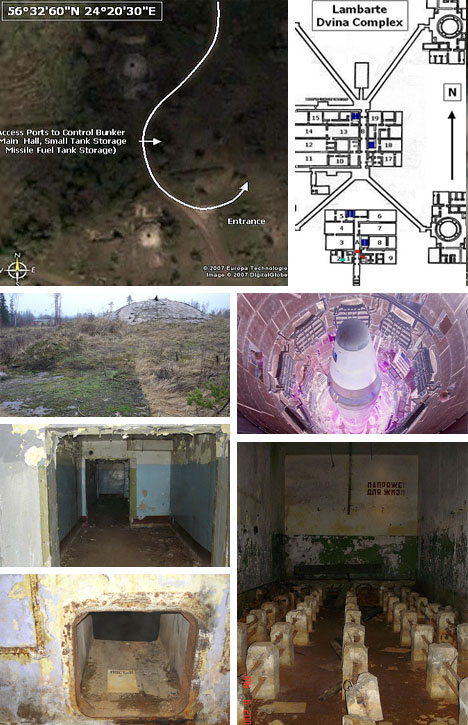
Abandoned Missile Silo Complex: Of course, the breakup of the Soviet Union was followed by a significant nuclear disarmament leaving deserted silos scattered about the Russian countryside. The particular complex shown in the image above is located in Latvia and contains four silos as well as a central command and technical support bunker. Now decommissioned, some such silos are open for public tourist visitation.
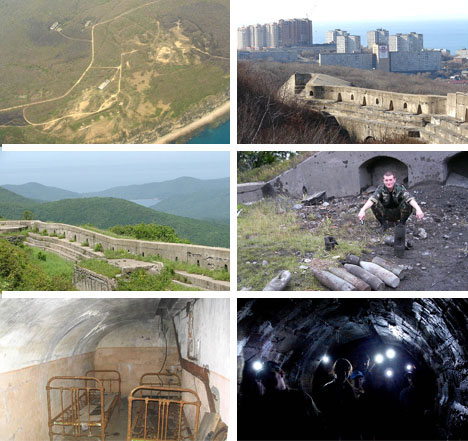
Abandoned Oceanside Fortress: Water fortifications were deemed necessary on the east coast of the Soviet Union to protect against possible attacks from Japan. In the southeast of Russia, Vladivostok is the largest port city on the Pacific Ocean. The fort and miles of tunnels featured in the photographs above have since fallen in disarray, but were once a highly prized (and extravagantly expensive) Russian defense construction project. Today it is a destination for Russian and other visitors complete with antiquated bombs and guided tours.
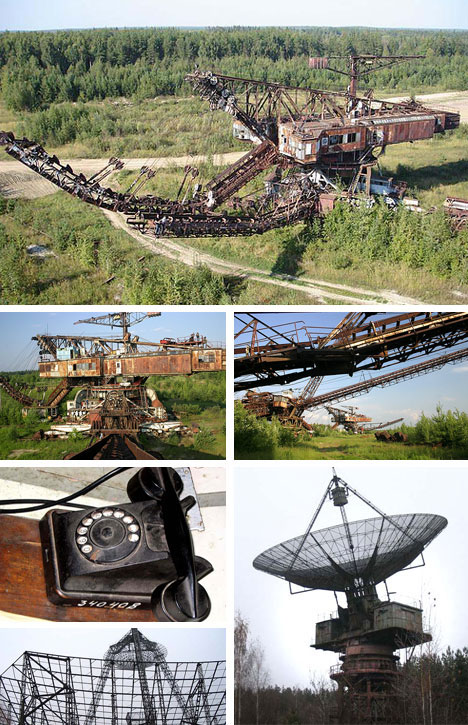
Abandoned Heavy Equipment: It is somewhat hard to imagine how incredibly costly and complex industrial and communications machines could ever be worth abandoning, yet in Russia one finds giant mining contraptions and satellite arrays left largely to succumb to the elements. The giant communications dish above is the size of a soccer field yet sits essentially idle today.
Posted by gjblass at 3:34 PM 0 comments
Amazing Young Organ Player Rocks Out
Amazing Young Organ Player Rocks Out - Watch more free videos
Posted by gjblass at 2:49 PM 0 comments
Pink Floyd: The Wall screenplay

The Wall Screenplay
Here is your chance to download this historic Floydian document.
Created in 1981 for 'The Wall' movie. This is the screenplay that was written by Roger Waters & illustrated by Gerald Scarfe.
Click on the graphics to download. Left mouse click to view online (best for fast connections) or Right mouse click & save as to download to your hard drive for viewing later.
( With many thanks to Nick Hawes )

Pages 1 - 10

Pages 11 - 20

Pages 21 - 30

Pages 31 - 40

Pages 41 - 50

Pages 51 - 60

Pages 61 - 70

Pages 71 - 80

Pages 81 - 94
Posted by gjblass at 2:30 PM 0 comments
16 year-old builds electric pickup truck

We all know the major manufacturers are saying it can’t be done, so I guess it’s up to the youth!
Andrew Angelloti, an Ecomodder forum member, converted his very own 1988 Mazda pickup to run on electricity last year, using $6,000 he had saved up from his part time job as a life guard. He built his truck using 20 flooded lead acid batteries to create 120 volts, which he couples to a 60 HP 9” electric motor.
How does it perform? Reaches a top speed of 55mph, has an acceleration of “not too bad…,” and can get up to 40 miles on a charge (which is more than enough to get him to work and back, and coincidentally, will be something similar to what the Chevy Volt is supposed to be able to do).
What’s even more amazing is that Andrew is now working on a second EV conversion. This time he’s doing the same with a 1992 Toyota Tercel, but with a much bigger motor for a lot more speed. He’s hoping to use a 120HP motor to have the top speed up to 80 MPH with a bit of sacrifice of the range.
I wish Andrew the best of luck, as he is certainly going out there and doing it on his own, without waiting for the major manufacturers to do it for him.
For more information, check out these links:
Posted by gjblass at 1:34 PM 0 comments
Well Done: a food company annual report that has to be cooked first
November 13th, 2007

Croatian creative agency Bruketa & Zinić have designed an annual report for food company Podravka that has to be baked in an oven before it can be read.

Called Well Done, the report features blank pages printed with thermo-reactive ink that, after being wrapped in foil and cooked for 25 minutes, reveal text and images.

Here are details from Bruketa & Zinić:
–
Well Done, the annual report for food company you have to bake before use
Empty pages become filled with content after being baked at 100°C for 25 minutes.

“Well done” created by Bruketa & Zinić is the new annual report for Podravka, the biggest food company in South-East Europe. It consists of two parts:
- a big book containing numbers and a report of an independent auditor
- a small booklet that is inserted inside the big one that contains the very heart of Podravka as a brand: great Podravka’s recipes.

To be able to cook like Podravka you need to be a precise cook. That is why the small Podravka booklet is printed in invisible, thermo-reactive ink. To be able to reveal Podravka’s secrets you need to cover the small booklet in aluminium foil and bake it at 100 degrees Celsius for 25 minutes.

If you are not precise, the booklet will burn, just as any overcooked meal. If you have successfully baked your sample of the annual report, the empty pages will become filled with text, and the illustrations with empty plates filled with food.

The annual report is printed on paper Conqueror Laid Brilliant White 120 g/m2, Munken Polar 130 g/m2 and Soporset 90 g/m2 and written with typography Thema by Nikola Djurek and Lexicon by Bram De Does.

The creative team of the project consists of Creative Directors Davor Bruketa & Nikola Zinić; Art directors Davor Bruketa, Nikola Zinić, Imelda Ramovi, Mirel Hadžijusufović; Copywriters Davor Bruketa, Nikola Zinić, Lana Cavar, Teo Tarabarić, Project manager Mirna Grzelj; Prepress: Danko Đurašin and editor Drenislav Zekić.

This is the seventh annual report for Podravka designed by Bruketa & Zinić OM. Those seven books won numerous awards worldwide such as London International Awards (Gold), Art Directors Club New York (Silver), Red Dot (Best of the Best), Cresta (Winner of Category), I.D. Annual Design Review (Best of Category), Type Directors Club (Typographic Excellence), Graphis (Gold) , Creativity (Gold) , Good Design (Graphics Award), HOW International Design Awards (Best of Show), Moscow International Advertising Festival (Gold), International Forum Communication Design (Design Award) and ARC Awards (Gold).
Bruketa & Zinić OM is a 60-people independent agency based in Zagreb, Croatia. It was established 10 years ago. The agency has been awarded for their projects by many prestigious contests and their work has been presented in many publications, books and exhibitions worldwide.
Posted by gjblass at 12:29 PM 0 comments
New Purification Plant Answers California's Water Crisis
FOUNTAIN VALLEY, California -- As Southern California faces a worsening water crisis, Orange County has implemented a $480 million microfiltration system so advanced it can turn waste water into drinking water. The Groundwater Replenishment System, which started pumping purified water on Jan. 10th, is the largest of its kind in the world and will provide water to more than 100,000 Orange County families for the same or less than buying it wholesale. And because sewage is diverted to the purification system, less waste is dumped into natural water supplies.
The new plant is likely to be the first of many as other cities in California, Texas and Florida consider similar plans. Read on as we follow the filtration process on 70 million gallons a day from beginning to end, where it's pumped into the Orange County basin aquifer.
Left: Low-pressure inline pumps (the blue and orange objects at ground level) move treated sewage through microfilters. The stainless steel pipes are cleaned with citric acid weekly.
Photo: Dave Bullock/Wired
Posted by Chismillionaire at 11:52 AM 0 comments
This day in tech 1807- The Gas Light!
1807: London's Pall Mall becomes the first street anywhere to be illuminated by gaslight.
The gaslight was developed in the 1790s. The credit usually goes to Scottish engineer William Murdoch, but it was Friedrich Albert Winzer (sometimes anglicized to Frederick Winsor), a German entrepreneur living in London, who lit Pall Mall.
In 1804, the same year he patented coal-gas lighting, Winzer demonstrated the technology during a lecture at London's Lyceum Theatre. By 1807, he had moved into a house on Pall Mall, one of the city's most fashionable streets.
He followed the illumination of Pall Mall with a special exhibition on June 4, 1807, in honor of the birthday of King George III, using gaslight to superimpose images against the walls of the buildings along his street.
The gaslight, meanwhile, took off. The Gas Light and Coke Co. -- the first public gas company -- was established, and by 1823, 40,000 lamps covered 215 miles of London's streets.
The gaslight remained the primary means of street illumination in Europe and North America throughout the 19th century.
Although it is certainly antiquated technology today, the gaslight retains a charm that electric lighting simply can't match. As a result, public illumination using gaslights is still found, usually in the historic districts of older cities. (In the United States, gaslit neighborhoods can still be found in Boston, Cincinnati and New Orleans).
Gas Light and Coke Co., incidentally, remained in existence until it was nationalized in 1948.
Posted by Chismillionaire at 11:47 AM 0 comments
Nano Prospecting
Could nanotechnology help squeeze more oil and gas out of the ground? That's the hope of a consortium of energy companies that is putting millions of dollars into the development of new micro- and nanosensor technologies.
The seven companies that make up the Advanced Energy Consortium (AEC), which includes Halliburton Energy Services, BP America, and ConocoPhilips, will put up $21 million in total to fund the research. The aim is to develop subsurface sensors that can be used to improve both the discovery and the recovery of hydrocarbons.
"It's been a long time coming," says Wade Adams, director of the Richard E. Smalley Institute for Nanoscale Science and Technology at Rice University, in Houston, a technical partner to the consortium. "It's the first time the energy companies have got together to fund this kind of research, so it really is a big deal," he says.
Currently, even with the most advanced recovery techniques, only about 40 percent of the oil and gas in reservoirs can be recovered. The hope is that by injecting novel sensors into these reservoirs, it will be possible to more accurately map them in 3-D, increase the amount of fuel extracted, and minimize the environmental impact.
The financial investment--equivalent to $1 million per year from each company for three years--is "a very good sign," says Kris Pister, a professor of electrical engineering and computer science at the University of California, Berkeley, who has spent several years developing distributed sensors known as smart dust. It means that the energy companies now understand the potential of small-scale distributed-sensors technologies, he says.
"There is good reason to suspect that this technology could help," says Pister. Distributed wireless sensor technologies are becoming increasingly sophisticated, and now even have their own wireless standard: the highway addressable remote transducer, or HART.
Right now, the only way to find these reservoirs and gauge their precise size and capacity is through seismic means, or by simply drilling down. "But you don't get much information," says Adams. Surface and down-hole seismic techniques have limited resolution, while drilling can only take readings for the two-foot region surrounding the drill bore, he says.
Moreover, oil and gas reservoirs tend not to be formed in huge underground chasms, or wells, as many people think. Instead, the reservoirs are formed in porous rock formations, which act like high-pressure geological sponges, says Scott Tinker, director of the AEC, state geologist of Texas and a professor at the University of Texas, in Austin. "The pores are very small," he says. They can be anywhere from 10 microns to one micron in diameter. Because of their size, once the initial high pressure of the reservoir has been reduced by releasing some of the oil, this porosity can impede the flow of oil or gas through the rock formation. "It can take a lot of work to get the oil out of the rock," says Tinker.
Posted by Chismillionaire at 11:46 AM 0 comments
How to build a Bionic Eye
People don't think twice about wearing a Bluetooth headset to have conversations on their cell phones. Well, one day it might not be unusual to wear a contact lens that projects the phone's display directly onto the eye. Researchers at the University of Washington have taken an important first step toward building contact lenses that could do just that. By incorporating metal circuitry and light-emitting diodes (LEDs) into a polymer-based lens, they have created a functional circuit that is biologically compatible with the eye.
"If you look at the structure of a lens, it's just a simple polymer," says Babak Parviz, professor of electrical engineering at the University of Washington. A number of researchers are putting electronics into polymers to build flexible circuits or displays, for instance. "What we realized was, we can make a lot of functional devices that are really tiny, and they can be incorporated into a contact lens to do a lot more than just improve vision," Parviz says.
The team created the electronic lens with two main purposes in mind, he says. One of the goals was to see if it would be possible to build a heads-up display that could superimpose images onto a person's field of view, while still allowing her to see the real world. It would be a sort of augmented reality, explains Parviz. (See "TR10: Augmented Reality.") Soldiers could use the technology to see information about their environment, collected from sensors. Or civilians could use the electronic lens as a cell-phone display, to see who is calling and to watch videos during a commute, although these goals are long term, he says.
Another possible application is to use the lens as a sensor that could monitor chemical levels in the body and notify the user if they indicate signs of disease. Although Parviz won't go into details about the specific sensors that his team is making, he explains that many indicators of health can be monitored from the surface of the eye. The live cells on the eye, he says, are in indirect contact with blood serum, which contains biomarkers for diseases. If a sensor designed to pick up these biomarkers was built into a lens, then doctors could have a completely new, noninvasive tool for disease tests. In addition, the lens could continually monitor changes over time, providing a more complete view of a person's health.
Admittedly, these applications are years away. But Parviz and his team have laid the foundation for the work. In a paper presented at the International Conference of Micro Electric Mechanical Systems in Tucson, AZ, last week, the researchers describe how they created a lens with 16 working LEDs. The lens was made from a polyethylene tetraphthalate substrate--the kind of plastic used in beverage bottles--which was covered with metal wires for connecting the LEDs.
Posted by Chismillionaire at 11:39 AM 0 comments









